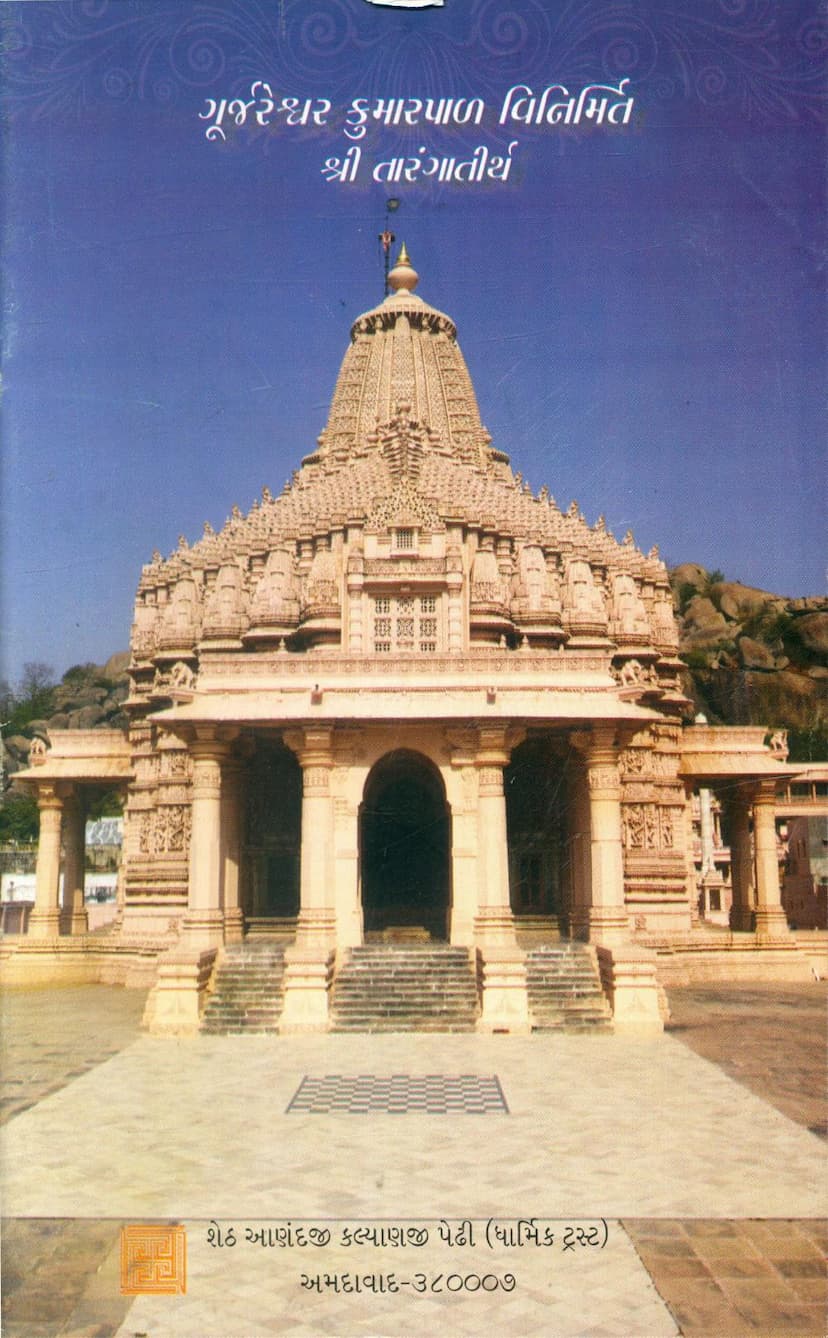Kumarpal Vinirmit Taranga Tirth
Added to library: September 2, 2025

Summary
Here's a comprehensive summary in English of the Jain text "Kumarpal Vinirmit Taranga Tirth":
This book, published by the Anandji Kalyanji Pedhi, details the historical significance, architectural grandeur, and spiritual importance of the Taranga Tirth, a renowned Jain pilgrimage site located in Gujarat, India. The text highlights its deep connection with the Solanki dynasty, particularly King Kumarpal and the esteemed Jain Acharya Hemchandrasuri.
Key Highlights of the Book:
-
Historical Origins and Patronage:
- The Tirth is attributed to King Kumarpal, who constructed the main Ajitnath Jinprasada (temple) in Vikram Samvat 1334 (1278 CE).
- Later, in Vikram Samvat 1479 (1423 CE), it was renovated and re-consecrated by Govind Shreshthi of Idar.
- The text traces the origins back to a Buddhist king named Veni Vatsaraj, who built a temple to 'Taradevi' here, leading to the place being known as 'Tarapur'. Subsequently, under the influence of Arya Khaputacharya, he converted to Jainism and established a temple for Siddhayikadevi, the tutelary deity of Jinas, making it a Jain pilgrimage site.
- The history of the Tirth between the 13th century and Kumarpal's reign is less clear.
-
Architectural Marvels and Artistry:
- Taranga is described as a unique mountain-top pilgrimage site in Gujarat, known for its exquisite architecture and intricate carvings.
- The main temple, dedicated to Lord Ajitnath, is a magnificent structure with a grand precinct. It was built under the order of King Kumarpal, with his minister Dandnayak Abhay overseeing its construction.
- The temple is renowned for its imposing shikhara (spire) and the detailed sculptural work on its walls, depicting various deities, celestial beings, and dancers in different postures. The craftsmanship is noted to be in line with Shilpa Shastra principles, showcasing the Solanki era's aesthetic brilliance.
- The temple complex features a large courtyard (approximately 230 feet long and wide) with the main temple at its center. The entire structure is built with Kharak stone, and the precise mixing of brick and lime has ensured its durability for over 800 years.
- The entrance and main deity are eastward-facing. The entrance features sculptures of Ambika Mata and door guardians. The temple has three grand entrances with architraves (Trishakha Dwar) and decorative motifs (Grasamukh) at the thresholds.
- The internal structure includes a Garbhagriha (sanctum), Gudhmandap (inner hall), Rangmandap (assembly hall), and Chowkis (platforms).
- The Rangmandap is a large hall supported by pillars, adorned with intricate carvings of Vidyadharas and divine dancers in various colors, evoking devotional art forms of ancient India.
- The text also mentions a unique wooden structure (Kagar/Tegar) used in the temple's construction, which is fire-resistant and releases water when exposed to fire.
- Specific mentions are made of the Sahastrakoot (thousand spire) temple and the Nandishwardweep temple, showcasing complex geometric designs and numerous sculpted figures.
-
Key Deities and Sculptures:
- The central deity is Lord Ajitnath, the second Tirthankar. His idol is described as being 15.5 hands tall, large, and captivating. Ladders made of wood are placed on either side to facilitate worship at the head.
- The temple houses several other significant sculptures and artifacts, including:
- Padukas (footprints) of Lord Ajitnath and various saints.
- Choumukhji (four-faced) idols, particularly of Lord Parshvanath, and a large temple dedicated to them.
- The Sahastrakoot, featuring 1024 sculpted images of Tirthankaras.
- Pattas (panels) depicting the Vishsthanak, Madhubindu, Siddha Chakra, and the fourteen Rajaloka (realms of existence).
- Sculptures depicting Ashtapad (Mount Kailash) with Tirthankaras and their symbols, and Samet Shikhar.
- Kaussagga (meditative posture) statues, some of which were brought from nearby villages.
-
Other Important Sites within the Tirth:
- Kotishila: A hill named after the belief that millions of muni (ascetics) attained liberation here. It features a Chaumukhji temple and is described in the Sanskrit poem 'Heer Saubhagya'.
- Siddhashila: Another hill known for its Jain temples, housing idols of Suparshvanath, Parshvanath, Aranatha, and Neminatha.
- Moksha (Punyakal) Bari: A shrine on a hill, dedicated to Lord Ajitnath's footprints, with ancient inscriptions.
- Jogidani Gufa: A cave with carved Buddha images, attracting crowds during Kartik Purnima and Chaitra Purnima fairs.
- Taran Mata Temple: Located at the foot of the mountain, this ancient temple houses a white stone idol of Taradevi.
-
Preservation and Renovation:
- The text acknowledges the passage of time and natural elements leading to the deterioration and damage of some sculptures and structures.
- In Vikram Samvat 1997 (1921 CE), the administration of the Tirth was handed over to the Anandji Kalyanji Pedhi.
- A significant restoration effort was undertaken by the Pedhi in 1963 CE, led by Seth Shri Kasturbhai Lalbhai and guided by the renowned Sompura Mansukhbhai and his team. This extensive renovation, which took 13 years and involved substantial financial expenditure, aimed to meticulously restore the damaged sculptures, often using plaster of Paris molds before crafting replacements from suitable stone.
-
Facilities for Pilgrims:
- The Tirth provides excellent facilities for pilgrims, including four well-equipped Dharmashalas (guesthouses), a Bhojanshala (dining hall), and Upashrayas (residences for monks and nuns).
- The Anandji Kalyanji Pedhi also maintains a Gyanbhandar (library) with religious literature and sells publications.
In essence, "Kumarpal Vinirmit Taranga Tirth" serves as a comprehensive guide to this sacred site, celebrating its historical legacy, artistic achievements, and spiritual significance, while also detailing the efforts undertaken for its preservation and the amenities available to visitors. It underscores the Tirth's enduring appeal as a living monument of Jain art and architecture and a place of profound spiritual devotion.